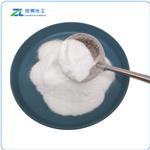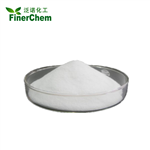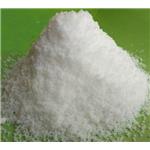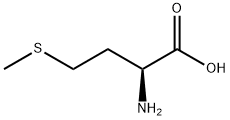DL-Methionine
- CAS No.
- 59-51-8
- Chemical Name:
- DL-Methionine
- Synonyms
- METHIONINE;MET;L-MET;H-MET-OH;RACEMETHIONINE;Urimeth;200-432-1;Thiomedon;H-L-MET-OH;DL-2-Amino
- CBNumber:
- CB6208758
- Molecular Formula:
- C5H11NO2S
- Molecular Weight:
- 149.21
- MDL Number:
- MFCD00063097
- MOL File:
- 59-51-8.mol
- MSDS File:
- SDS
| Melting point | 284 °C (dec.)(lit.) |
|---|---|
| alpha | -1~+1°(D/20℃)(c=8,HCl) |
| Boiling point | 306.9±37.0 °C(Predicted) |
| Density | 1.34 |
| FEMA | 3301 | D,L-METHIONINE |
| refractive index | 1.5216 (estimate) |
| storage temp. | 2-8°C |
| solubility | 1 M HCl: 0.5 M at 20 °C, clear, colorless |
| pka | 2.13(at 25℃) |
| form | Crystals or Crystalline Powder |
| color | White |
| Odor | mild sulfurous acidic |
| Odor Type | acidic |
| optical activity | [α]/D, c = 5 in 5 M HCl (inactive) |
| Water Solubility | 2.9 g/100 mL (20 ºC) |
| Merck | 14,5975 |
| JECFA Number | 1424 |
| BRN | 636185 |
| BCS Class | 1 |
| Stability | Stable. Incompatible with strong oxidising agents. |
| InChIKey | FFEARJCKVFRZRR-UHFFFAOYSA-N |
| LogP | 0.37 |
| Substances Added to Food (formerly EAFUS) | DL-METHIONINE |
| FDA 21 CFR | 310.545 |
| CAS DataBase Reference | 59-51-8(CAS DataBase Reference) |
| FDA UNII | 73JWT2K6T3 |
| NIST Chemistry Reference | Methionine(59-51-8) |
| EPA Substance Registry System | Methionine (59-51-8) |
SAFETY
Risk and Safety Statements
| Hazard Codes | Xi | |||||||||
|---|---|---|---|---|---|---|---|---|---|---|
| Risk Statements | 33-36/37/38 | |||||||||
| Safety Statements | 24/25-36-26 | |||||||||
| WGK Germany | 2 | |||||||||
| RTECS | PD0457000 | |||||||||
| F | 10-23 | |||||||||
| TSCA | Yes | |||||||||
| HS Code | 29304090 | |||||||||
| NFPA 704 |
|
DL-Methionine price More Price(57)
| Manufacturer | Product number | Product description | CAS number | Packaging | Price | Updated | Buy |
|---|---|---|---|---|---|---|---|
| Sigma-Aldrich | PHR2653 | Racemethionine Pharmaceutical Secondary Standard; Certified Reference Material | 59-51-8 | 500MG | $267 | 2024-03-01 | Buy |
| Sigma-Aldrich | 64340 | DL-Methionine ≥99.0% (NT) | 59-51-8 | 1kg | $108 | 2024-03-01 | Buy |
| Sigma-Aldrich | 1643292 | Racemethionine United States Pharmacopeia (USP) Reference Standard | 59-51-8 | 200mg | $424 | 2024-03-01 | Buy |
| TCI Chemical | M0463 | DL-Methionine >99.0%(HPLC)(T) | 59-51-8 | 25g | $17 | 2024-03-01 | Buy |
| TCI Chemical | M0463 | DL-Methionine >99.0%(HPLC)(T) | 59-51-8 | 500g | $95 | 2024-03-01 | Buy |
DL-Methionine Chemical Properties,Uses,Production
Description
Methionine (2-amino-4(methylthio)-butanoic acid) is one of the essential amino acids, which are used by our bodies to make proteins and can only be supplied by diets. Methionine is found in metal, fish, and dairy products, and it plays an important role in many cell functions.
With an asymmetric carbon, methionine molecules can be D (Dextrogyre) or L (Levogyre), optical isomers. L-methionine is the biologically active form of methionine in proteins. D-methionine is converted into L-methionine by enzymatic processes inside animal bodies in such a way that L- and D-methionine are equivalent for animal nutrition. D,L-methionine (DLM) is the most common form of commercialized methionine, composed of the racemic mixture of D and L-methionine. D,L-methionine is commercialized as a white crystalline powder, containing 99% of active substance, or in a brown liquid form with 40% purity, made from the dissolution of D,L-methionine in sodium hydroxide.
Methionine is used to prevent liver damage in acetaminophen (Tylenol) poisoning. It is also used to increase the acidity of urine, to treat liver disorders, and to improve wound healing. Furthermore, it is used for the treatment of depression, alcoholism, allergies, asthma, copper poisoning, radiation side effects, schizophrenia, drug withdrawal, and Parkinson's disease. Methionine is registered as an ingredient for use in cosmetics as antistatic and for skin conditioning (Commission Decision 2006/257/EC).
D,L-methionine is used in animal feeds for poultry and pigs, as well as in diets for cats and dogs. D,L-methionine technically pure protected with copolymer vinylpyridine/styrene, and D,L-methionine protected with ethylcellulose when used as a feed additive for ruminants, are currently authorized for use for all animal species and ruminants, respectively, by Regulation (EU) No 469/2013.
References
[1] DL-Methionine from Methional and Hyddrogen Cyanide – Cost Analysis – Methionine E11A (2016)
[2] http://www.rxlist.com/methionine/supplements.htm
[3] http://onlinelibrary.wiley.com/doi/10.2903/j.efsa.2012.2623/abstract
Description
Methionine is an α-amino acid with the chemical formula HO2CCH(NH2)CH2CH2SCH3. This essential amino acid is classified as nonpolar. This amino-acid is coded by the initiation codon AUG which indicates mRNA's coding region where translation into protein begins.
Chemical Properties
d,l-Methionine has a characteristic odor. It is an essential amino acid and is also used as a nutrient and dietary supplement.
Chemical Properties
White, crystalline platelets or powder having a characteristic odor. One g dissolves in about 30 mL of water. It is soluble in dilute acids and in solutions of alkali hydroxides. It is very slightly soluble in alcohol, and practically insoluble in ether. It is optically inactive. The pH of a 1 in 100 solution is between 5.6 and 6.1. This substance may be prepared by addition of methanethiol to acrolein; by chemical conversion of methylthiopropionic aldehyde.
Chemical Properties
White crystalline powder
Occurrence
High levels of methionine can be found in eggs, sesame seeds, Brazil nuts, fish, meats and some other plant seeds; methionine is also found in cereal grains. Most fruits and vegetables contain very little of it. Most legumes are also low in methionine. Racemic methionine is sometimes added as an ingredient to pet foods.
Uses
DL-Methionine is sometimes given as a supplement to dogs; it helps keep dogs from damaging grass by reducing the pH of the urine.
Methionine is allowed as a supplement to organic poultry feed under the US certified organic program.
Uses
Production of volatile compounds related to the flavour of foods from the Strecker degradation of DL-methionine. Addition of methionine in appropriate amounts to these foods might be expected to improve protein value. Economically, DL-methionine would be preferable.
Uses
An essential nonpolar amino acid with oxidative stress defense properties
Preparation
By addition of methanethiol to acrolein; by chemical conversion of methylthiopropionic aldehyde.
Definition
ChEBI: A sulfur-containing amino acid that is butyric acid bearing an amino substituent at position 2 and a methylthio substituent at position 4.
brand name
Pedameth (Forest).
Biosynthesis
As an essential amino acid, methionine is not synthesized de novo in humans, who must ingest methionine or methioninecontaining proteins. In plants and microorganisms, methionine is synthesized via a pathway that uses both aspartic acid and cysteine. First, aspartic acid is converted via β-aspartyl-semialdehyde into homoserine, introducing the pair of contiguous methylene groups. Homoserine converts to O-succinyl homoserine, which then reacts with cysteine to produce cystathionine, which is cleaved to yield homocysteine. Subsequent methylation of the thiol group by folates affords methionine. Both cystathionine-γ-synthase and cystathionine- β-lyase require pyridoxyl-5′-phosphate as a cofactor, whereas homocysteine methyltransferase requires vitamin B12 as a cofactor.
Biotechnological Production
DL-Methionine is the second amino acid that is almost exclusively manufactured by chemical synthesis. The process used today was originally developed by Werner Schwarze at Degussa in the 1940s, and has been continually improved and refined since. Today DL-methionine is manufactured in several plants, each with a capacity of more than 100,000 tonnes. To operate the process on an industrial scale also requires back-integration into the key hazardous raw materials acrolein, methyl mercaptan, and hydrogen cyanide. After the formation of the hydantoin, the key step is alkaline hydrolysis of the hydantoin, to produce methionine directly in up to 95 % yield based on acrolein.
Biological Functions
Together with cysteine, methionine is one of two sulfurcontaining proteinogenic amino acids. Its derivative S-adenosyl methionine (SAM) serves as a methyl donor. Methionine is an intermediate in the biosynthesis of cysteine, carnitine, taurine, lecithin, phosphatidylcholine, and other phospholipids. Improper conversion of methionine can lead to atherosclerosis.
This amino acid is also used by plants for synthesis of ethylene. The process is known as the Yang Cycle or the methionine cycle.
Methionine is one of only two amino acids encoded by a single codon (AUG) in the standard genetic code (tryptophan, encoded by UGG, is the other). The codon AUG is also the most common eukaryote "Start" message for a ribosome that signals the initiation of protein translation from mRNA when the AUG codon is in a Kozak consensus sequence. As a consequence, methionine is often incorporated into the N-terminal position of proteins in eukaryotes and archaea during translation, although it can be removed by post-translational modification. In bacteria, the derivative Nformylmethionine is used as the initial amino acid.
General Description
DL-Methionine is an essential amino acid containing sulphur. Methionine consists of an asymmetric carbon and exists as D (dextrogyre) and L (levogyre) optical isomers. The L-methionine is considered as biologically active. The racemic mixture of D and L-isomers forms DL-methionine, which is the commercially available methionine.
Biochem/physiol Actions
Methionine offers protection against disorders related to hair, skin and nails. It elevates lecithin production in the liver and thereby reduces cholesterol level. It naturally serves as a heavy metal chelating agent, regulating ammonia concentration in the urine. This ameliorates bladder irritation. Methionine is also known to induce hair growth.
Safety Profile
Moderately toxic by ingestion and other routes. An experimental teratogen. Experimental reproductive effects. When heated to decomposition it emits toxic fumes of SOx and NOx. See also 1-METHIONINE.
Purification Methods
Crystallise it from hot water or EtOH. Also purify it by dissolving it in H2O and passing through an Amberlite IR-120 resin (NH4+ form). The eluate is concentrated and then passed through Amberlite IR-4B resin, and this eluate is evaporated to dryness. The residue is washed with EtOH, then Me2CO, dried and recrystallised from aqueous EtOH (colourless plates) [Baddiley & Jamieson J Chem Soc 4283 1954]. [Greenstein & Winitz The Chemistry of the Amino Acids J. Wiley, Vol 3 p 2125 1961, Beilstein 4 IV 3190.]
Other biochemical pathways
Although mammals cannot synthesize methionine, they can still use it in a variety of biochemical pathways:
Generation of homocysteine Methionine is converted to S-adenosyl methionine (SAM) by (1) methionine adenosyltransferase.
SAM serves as a methyl-donor in many (2) methyl transferase reactions, and is converted to S-adenosylhomocysteine (SAH).
(3) Adenosyl homocysteinase converts SAH to homocysteine.
There are two fates of homocysteine: it can be used to regenerate methionine, or to form cysteine.
Regeneration of methionine
Methionine can be regenerated from homocysteine via methionine synthase in a reaction that requires Vitamin B12 as a cofactor.
Homocysteine can also be remethylated using glycine betaine (NNN-trimethyl glycine, TMG) to methionine via the enzyme betainehomocysteine methyltransferase (E.C.2.1.1.5, BHMT). BHMT makes up to 1.5% of all the soluble protein of the liver, and recent evidence suggests that it may have a greater influence on methionine and homocysteine homeostasis than methionine synthase.
DL-Methionine Preparation Products And Raw materials
Raw materials
1of2
Preparation Products
1of3
| Supplier | Tel | Country | ProdList | Advantage | |
|---|---|---|---|---|---|
| Hebei Weibang Biotechnology Co., Ltd | +8615531157085 | abby@weibangbio.com | China | 8811 | 58 |
| Shaanxi Dideu Medichem Co. Ltd | +86-29-81148696 +86-15536356810 | 1022@dideu.com | China | 3882 | 58 |
| Hebei Mojin Biotechnology Co., Ltd | +86 13288715578 +8613288715578 | sales@hbmojin.com | China | 12839 | 58 |
| Hebei Chuanghai Biotechnology Co,.LTD | +86-13131129325 | sales1@chuanghaibio.com | China | 5892 | 58 |
| Changzhou waston chemical technology Co.,Ltd | +86-051985861892 +8618112881323 | info@wastonchem.com | China | 250 | 58 |
| Hebei Kingfiner Technology Development Co.Ltd | +86-15532196582 +86-15373005021 | lisa@kingfinertech.com | China | 3010 | 58 |
| Across Biotech Jinan Co LTD | +8613031735486 | frank@acrossbiotech.com | China | 105 | 58 |
| Nantong Guangyuan Chemicl Co,Ltd | +undefined17712220823 | admin@guyunchem.com | China | 615 | 58 |
| Shaanxi TNJONE Pharmaceutical Co., Ltd | +8618092446649 | sarah@tnjone.com | China | 1143 | 58 |
| Hebei Zhuanglai Chemical Trading Co.,Ltd | +8613343047651 | admin@zlchemi.com | China | 3002 | 58 |
Related articles
- Methionine synthesis and Methionine benefits
- Methionine is an essential amino acid found in meat, fish, and dairy products. It is an amino acid that is used to build molec....
- Jul 24,2024
View Lastest Price from DL-Methionine manufacturers
| Image | Update time | Product | Price | Min. Order | Purity | Supply Ability | Manufacturer | |
|---|---|---|---|---|---|---|---|---|
 |
2024-11-25 | DL-Methionine
59-51-8
|
US $36.00 / kg | 1kg | 99% | 5000kg/week | Hebei Zhuanglai Chemical Trading Co.,Ltd | |
 |
2024-11-25 | DL-Methionine
59-51-8
|
US $4.00 / kg | 1kg | 99% | 200mt | Jinan Finer Chemical Co., Ltd | |
 |
2024-11-25 | DL-Methionine
59-51-8
|
US $100.00-75.00 / kg | 1kg | 99% | 5000Ton | HEBEI SHENGSUAN CHEMICAL INDUSTRY CO.,LTD |
-

- DL-Methionine
59-51-8
- US $36.00 / kg
- 99%
- Hebei Zhuanglai Chemical Trading Co.,Ltd
-

- DL-Methionine
59-51-8
- US $4.00 / kg
- 99%
- Jinan Finer Chemical Co., Ltd
-

- DL-Methionine
59-51-8
- US $100.00-75.00 / kg
- 99%
- HEBEI SHENGSUAN CHEMICAL INDUSTRY CO.,LTD





